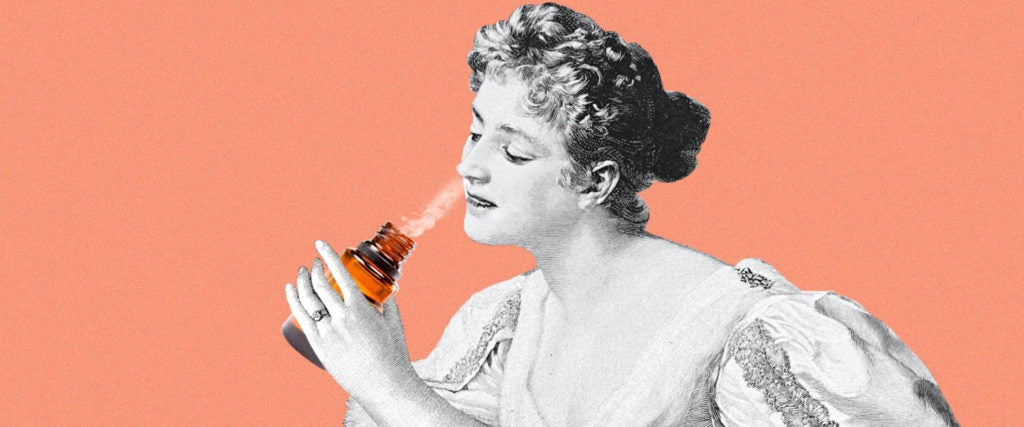Few drugs have a hornier reputation than poppers, the slang term for a chemical class of liquid drugs called alkyl nitrites. These inhalants are sniffed primarily because their vapor gives a warm, dizzying rush, but they’re also sought out by hungry bottoms due to their muscle-relaxant properties — they’re known to gently slacken your butthole before a rousing round of anal sex.
Being railed isn’t all they’re good for, though. Dive deep into medical history and you’ll find that amyl nitrite, arguably the most common poppers variant even today (although butyl nitrite is creeping up), was originally prescribed by 19th century doctors as a cure for chest pain, and even — poppers fans with vulvas, rejoice! — period pain.
Researcher Adam Zmith stumbled upon this surprising, hugely under-acknowledged revelation when writing his recently released book, Deep Sniff: A History of Poppers and Queer Futures. Late in the process of polishing the text, he stumbled across an 1883 first edition of Martindale Extra Pharmacopoeia, a “huge catalogue of all the known substances that pharmacologists and doctors used to treat different kinds of ailments.” It was in this dusty old book that he found conclusive evidence poppers were, at least in Victorian England, once recommended for “dysmenorrhea” — the medical term for period pain.
To understand why, it’s worth explaining what poppers actually do. Alkyl nitrites are what’s known as vasodilators, meaning they dilate the blood vessels. This results in increased blood flow — the aforementioned rush — and muscle relaxation, each of which explains why the vasodilatory drugs were regularly prescribed for pain relief.
“Amyl nitrite for period pain didn’t catch on as much as it did for other medical uses,” continues Zmith, “but it was definitely recommended. It’s about lowering your blood pressure and relieving your muscles, and that’s one thing that happens when you get your period — your muscles are just not having a good time.”
In 1906, a doctor at London’s Charing Cross Hospital named Amand Routh gave an entire lecture about various types of dysmenorrhea. In it, he said, “If the extremities are cold or if the patient feels chilly, prompt relief may be afforded by the inhalation of amyl nitrite.” Zmith laughs as he recalls the mention of “chilly” — the warm rush of poppers would definitely help that, at least — but it’s definitive proof that at least one doctor prescribed amyl nitrite for period pain.
As primary dysmenorrhea is caused by uterine contractions so strong that they press against nearby blood vessels to cut off the oxygen flow, it’s not implausible to suggest vasodilatory drugs could help. In fact, experimental trials of sildenafil (a vasodilatory drug otherwise known as Viagra) run in 2013 found it actually did help dysmenorrhea, yet another “win” for vasodilators as an intervention for pain.
According to Zmith, it’s unclear exactly when doctors stopped using them for pain management — although it was likely in the early 20th century, when medical scientist and hardcore poppers enthusiast T. Lauder Brunton passed away — but it likely has plenty to do with how dangerous they can be.
Along those lines, none of this is to say you should be huffing poppers on your period — and even if you do, the rush is so quick that the pain would likely subside for only a few minutes, max. It’s also important to note that the intoxicating liquid in these tiny bottles can be lethal when consumed, and can cause pretty serious chemical burns when spilled. They can even cause long-term issues, like respiratory conditions and methemoglobinemia, a pretty nasty blood disorder that can result in shortness of breath and loss of consciousness.
Despite these risks, there does seem to be scientific evidence to back up the notion that poppers and pain relief go hand-in-hand. If we don’t know about it yet, it’s largely because medical stigma means period pain is hugely under-researched — for context, it took until 2019 for a comprehensive study on it to be released. Still, if poppers can ease the pain of taking a giant dick, there’s arguably endless potential for these horny-inducing liquid stimulants to reclaim their rightful place in medical history.

